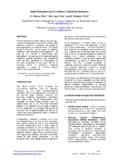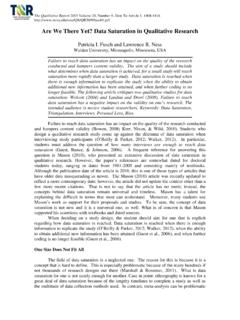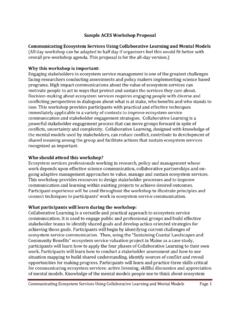Transcription of Sample Qualitative Research Proposal Published by ...
1 Sample Qualitative Research Proposal Published by Permission of the Author Dissertation Proposal Robert R. Maldonado Akamai University Title: A Phenomenological Pilot Study of Energy Healers Expertise and Recommendations for Energetic Disaster and Trauma Relief Training Introduction In order to effectively and consistently provide energetic disaster relief treatments for humanitarian disasters, there needs to be a training program to train volunteers and local social service providers. Few studies have focused on how to adequately and effectively integrate and train people in the knowledge of different energy systems in disaster relief. Some trauma relief organizations such as The Trauma Relief Committee of the Association of Thought Field Therapy, Green Cross Association of Traumatic Stress Specialists, Common Bond Institute--Catastrophic Trauma Recovery Project (CTR) and others, have had much success providing training and coordinating teams of practitioners to deploy to assist victims and workers in need during incidents of trauma and disaster.
2 The Association of Comprehensive Energy Psychology (ACEP) has provided initial relief work and training on a volunteer basis to local service providers during disasters (Feinstein, 2008). Despite the effective use of energy psychology in Singapore, Sri Lanka, and Indonesia by ACEP members, no comprehensive training program or organizational structure exists to train a core of dedicated trainers for this type of work. The ACEP Humanitarian Committee has been tasked with developing a training model of best practices and how to move forward (Bulbrook, 2009). A study that addresses/defines energetic disaster and trauma relief training is important for several reasons. First, it brings the strengths of many energy systems to the field in the aftermath of trauma and disasters. Second, it compiles a diverse wealth of potentially meaningful information/data from numerous experts in their respective fields that can be used to create a training program for relief workers in energetic disaster relief.
3 Finally, it brings this information to a wider audience of practitioners and organizations to assist them in the development of their own training programs in disaster relief. Purpose of the Study --the purpose of this phenomenological study is to explore and understand through the obtaining of information from key participants in their respective energy systems, what they can contribute to energetic disaster and trauma relief training. The overall aim of this study is to draw on the clinical expertise, field experience and the vision of key experts to help define the field of disaster relief training, identify needs and gaps, and make recommendations for further development in the implementation of energetic disaster preparedness and response efforts. Research Question 1) How do the experiences of the key participants contribute to energetic disaster and trauma relief training? Philosophical assumptions of the phenomenological strategy This study will utilize a descriptive Husserlian phenomenological strategy.
4 The Husserlian approach aims to identify the structure of experiences as described by the Research participants. Edmund Husserl, a German philosopher uncovered and described the fundamental structure of our life world emphasizing the description of a person s lived experience (Moustakas, 1994). Husserlian phenomenology, because of its descriptive orientation, is best suited for this study. This study will explore the lived experience of the participants in order to understand the essence of a person s account of their experiences as it relates to the phenomena in question energetic disaster and trauma relief training. Phenomenology is considered a process as well as a method, and the procedure involves studying a small number of subjects through extensive and prolonged engagement to develop patterns and relationships of meaning. In this process the researcher sets aside his own experiences in order to understand those of the participants in the study (Creswell, 2009).
5 The researcher will explore the individual lived experiences and expertise of the key participants through questionnaires and unstructured interviews. The participants were chosen because of their unique status, experience, and knowledge of their respective energy systems as they relate to disaster relief. This Research design is appropriate because the responses of the participants will be shared and used in the development of a training model and protocols. Qualitative Research strategy Role of the researcher The role of the researcher in this study necessitates the identification of personal values, assumptions and biases at the outset of the study. The researcher served as a special operations commander in the Air Force, training combat helicopter aircrews and participated in military humanitarian relief operations in both Haiti and Honduras. He is a practicing energy healer and teacher in private practice certified in numerous energy healing modalities.
6 He is also a current member of the Association of Comprehensive Energy Psychology (ACEP) humanitarian committee assisting in the development of a training model for humanitarian disaster relief. He believes that these experiences enhance his awareness, knowledge, and sensitivity to the issues being addressed in this study and will assist him in working with the key participants. Although every effort will be made to ensure objectivity, the researcher s personal bias may shape the way he views and understands the data that is collected and their interpretation. He recognizes the need to be open to the thoughts and opinions of others and to set aside his experiences in order to understand those of the participants in the study. Participants: The participants will be purposefully selected because of their unique expertise in their respective fields. The researcher will conduct the pilot study using a questionnaire and unstructured interviewing techniques; asking-open-ended questions of the participants about their unique expertise in their respective energy system and how it could contribute to disaster relief training.
7 An e-mail will be sent to the prospective participants asking them whether they would be interested in participating in a Research study about Energetic Disaster and Trauma Relief Training. Each participant will be contacted and a convenient location and time will be determined for the interview. Prior to the interview the researcher asked the participants to sign a consent form and completed a demographic form of relevant background data. Sample : purposeful sampling was used for the recruitment of participants for this study. Purposeful sampling is commonly used in Qualitative Research . It involves selecting Research participants according to the needs of the study ( Glaser Morse, 1991) in that researchers choose participants who give a richness of information that is suitable for detailed Research (Patton, 1980). The selection criteria for inclusion were professional who were the leaders in their respective field and who could articulate their experiences as it relates to the phenomena being investigated providing energetic disaster and trauma relief.
8 Data collection procedures . A protocol consisting of a written questionnaire and both e-mail and telephone interviews, will be used to obtain the data. A questionnaire will be mailed to each participant to be filled out and sent back to the researcher. Upon receipt and review of the completed questionnaire, a follow-up interview will be conducted to discuss and to ask the participants to explain their ideas in more detail and/or elaborate on what they have stated in the questionnaire. The researcher will use a non-directive style of interviewing using open-ended questions allowing the participants the freedom to control pacing and subject matter of the interview. Additionally, a more directive style of questioning will be used as needed when the researcher requires more clarification of information that the participants will be providing. The researcher will record the information from the telephone interview by making hand-written notes.
9 Additional sub-questions will also be used as needed. The researcher will initially field test a Sample questionnaire with 2 key participants to assess the type of questions for use throughout the study and to ensure that the data from the questions are valid and reliable. In the study the telephone interviews will assess face validity by comparing the responses on the questionnaire with the participant s real opinions. Reliability will be assessed through test-retest reproducibility by asking some of the participants to complete the questionnaire on more than one occasion. Some of the questions will be asked in more than one way to assess internal consistency. Acceptability will be determined by asking the participants how they found answering the questionnaire during the validity testing. This process will help identify main issues and form the basis of the type of questions to be used in the pilot study. A Sample of interview questions are at Appendix A A preliminary Sample of a questionnaire is at Appendix B.
10 Data Analysis Strategies for validating findings. Merriam (1998) and Marshall and Rossman (1989) contend that data collection and analysis must be a simultaneous process in Qualitative Research . They claim that Qualitative data analysis entails classifying things, persons, and events and the properties that characterize them. The Coliaizzi (1978) method of phenomenology uses Husserlian phenomenology to describe the essential structure of a phenomenon in its analysis. It was used to investigate the lived experiences of nurses giving spiritual care (Deal, 2010). Ballie (1996) conducted a phenomenological study using Colaizzi s method to understand the nature of empathy by nurses. Colaizzi s data analysis method appears to be an appropriate methodology for this study because it focuses on finding the essence and meaning of the experiences of the participants in providing energetic disaster and trauma relief. The Colaizzi analysis involves the following procedural steps: First, the researcher will read all participants questionnaires and transcribe the data collected from the interviews to get a general sense of the whole and ideas presented.









